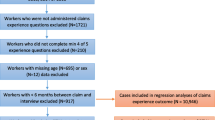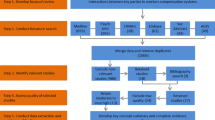Abstract
An appropriate paradigm for explaining the evident problems of motivating the workers' compensation claimant toward occupational recovery may be found in the learned helplessness model. This article examines the critical relationships in the workers' compensation system and the potential for development of the injured worker helplessness within that system. The author offers the learned helplessness model as an alternative framework through which injured worker behavior can be explained and understood. It is suggested that the non-contingent rewards and the uncontrollable dynamics characteristic of workers' compensation systems lead to claimants' learning helplessness. Finally, a total quality managed disability prevention system is offered as the organization's best approach to reducing the likelihood of learned helplessness.
Similar content being viewed by others
References
Seligman M.Helplessness. San Francisco: W.H. Freeman,1975.
Engberg H, Welker T. Acquisition of keypecking via autoshaping as a function of prior experience: “Learned Laziness?”Psychonom Soc 1973.
Kurlander H, Miller W, Seligman M. Learned helplessness, depression, and prisoner's dilemma. Submitted.
Abramson L, Seligman, Teasdale. Learned helplessness in humans: Critique and reformulation.J Abnorm Psychol 1978; 87: 49–74.
Seligman M.Learned optimism. New York: Alfred A. Knopf, 1991.
Larson,Law of workmen's compensation. New York: Bender and Company, 1980.
Mitchell K, Sinclair S. Co-malingering. Unpublished manuscript, 1990.
Satir V.Peoplemaking. Palo Alto:Science and Behavior Books, 1972.
Behan, Hirschfeld. Disability without disease or accident.Arch Environment Health 1966; 12: 655–659.
Galvin, DE, Habeck, Kerchner, K. A Report from the Leadership Forum on Disability Management. October 1992.
Akabas SA, Gates LB, Galvin DE.Disability management. New York: AMACOM, 1992.
Heffner F. The total quality disability management team.New Worker Winter 1992.
Author information
Authors and Affiliations
Rights and permissions
About this article
Cite this article
Walker, J.M. Injured worker helplessness: Critical relationships and systems level approach for intervention. J Occup Rehab 2, 201–209 (1992). https://doi.org/10.1007/BF01078998
Issue Date:
DOI: https://doi.org/10.1007/BF01078998




